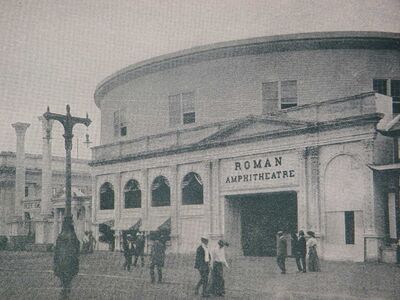Ancient Rome: Difference between revisions
No edit summary |
No edit summary |
||
| (20 intermediate revisions by the same user not shown) | |||
| Line 1: | Line 1: | ||
{{short description| | {{short description|Ancient Rome}} | ||
{{Infobox | {{Infobox FairBuilding | ||
| name = | | name = Ancient Rome | ||
| image = | | image = Ancient Rome Main.jpg | ||
| image_alt = | |||
| image_size = 300px | | image_size = 300px | ||
| caption = | | caption = Main entrance of Ancient Rome | ||
| alternate_name = | | alternate_name = | ||
| | | location = [[The Pike]] | ||
| | | no_buildings = 6 | ||
| | | construction_cost= | ||
| | | furnishing_cost = | ||
| | | profit = $46,904 (${{Format price|{{Inflation|US|46,904.60|1904}}}} in {{Inflation/year|US}}) | ||
| | | owner = | ||
| | | architect = | ||
| | | dimensions = | ||
| | | adult_entry = 10¢ (${{Inflation|US|.1|1904}} in {{Inflation/year|US}}) | ||
| | | child_entry = | ||
| other = | | other = | ||
}} | }} | ||
with over 400 actors employed in this Pike attraction, Ancient Rome gave [[The Pike]]-goers the illusion of going back in time to a life of gladiators and chariot races in the Augustine Period of Rome. | |||
The | |||
==Before the Fair== | ==Before the Fair== | ||
==Description== | ==Description== | ||
A large arena, called the Hippodrome showcased chariot race, jousting, boxing, and gladiatorial clashes with broadsword. | |||
Huge gladiatorial spectacles included: 200 persons, 40 animals (including tigers, lions, and leopards). | |||
The finale was a reproduction of Nero's Rome burning. | |||
On the premises was a restaurant for public and for Fair employees. | |||
Most visitors found Ancient Rome an educational exhibit. | |||
12 chariots were used for the shows. | |||
==Hawaiian Display== | |||
Inhabited in the same Ancient Rome attraction, there was a replica of Kilauea volcano, "The Spirit of Fire", a Hawaiian 'god' sported clouds of incense, smoke and artificial fire. The cyclorama of the Volcano of Kilauea, Hawaii was at 1893 Chicago World's Fair | |||
= | Walter W. Burridge, a painter, of Chicago, visited Hawaii and made a two-years' study of the mountain; thereafter, with a corps of assistants, he painted and built the cyclorama, the entire expense rising to $80,000 ({{Inflation|US|80,000|1904|fmt=eq}}). Also represented was the throne and uniform of the late king of Hawaii, with the furniture and equipment of his palace, relics of by-gone days. | ||
==See also== | ==See also== | ||
| Line 40: | Line 49: | ||
==External links== | ==External links== | ||
[[Category:Pike]] | |||
Latest revision as of 17:10, 15 November 2022
 | |
| Location | The Pike |
|---|---|
| No. of Buildings | 6 |
| Construction | |
| Proft | $46,904 ($1.41 million in 2021) |
| Entry | |
| Adult Entry | 10¢ ($3 in 2021) |
with over 400 actors employed in this Pike attraction, Ancient Rome gave The Pike-goers the illusion of going back in time to a life of gladiators and chariot races in the Augustine Period of Rome.
Before the Fair[edit | edit source]
Description[edit | edit source]
A large arena, called the Hippodrome showcased chariot race, jousting, boxing, and gladiatorial clashes with broadsword.
Huge gladiatorial spectacles included: 200 persons, 40 animals (including tigers, lions, and leopards).
The finale was a reproduction of Nero's Rome burning.
On the premises was a restaurant for public and for Fair employees.
Most visitors found Ancient Rome an educational exhibit.
12 chariots were used for the shows.
Hawaiian Display[edit | edit source]
Inhabited in the same Ancient Rome attraction, there was a replica of Kilauea volcano, "The Spirit of Fire", a Hawaiian 'god' sported clouds of incense, smoke and artificial fire. The cyclorama of the Volcano of Kilauea, Hawaii was at 1893 Chicago World's Fair
Walter W. Burridge, a painter, of Chicago, visited Hawaii and made a two-years' study of the mountain; thereafter, with a corps of assistants, he painted and built the cyclorama, the entire expense rising to $80,000 (equivalent to $2,412,741 in 2021). Also represented was the throne and uniform of the late king of Hawaii, with the furniture and equipment of his palace, relics of by-gone days.
